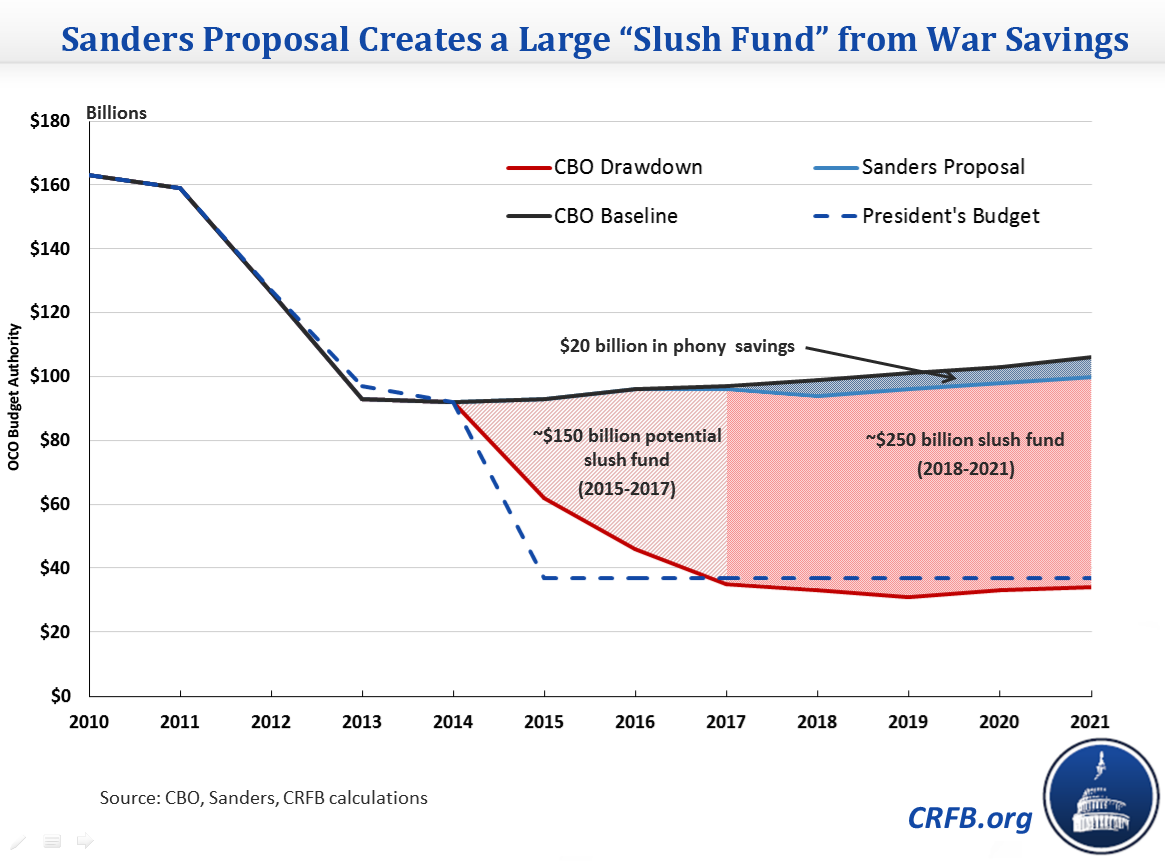Sanders Bill Would Add to the Debt, Create a $250 Billion Slush Fund
Soon, the Senate may consider the Comprehensive Veterans Health and Benefits and Military Retirement Pay Restoration Act legislation (the CBO scoring is available here) introduced by Senator Bernie Sanders (I-VT) to reverse the military retirement reforms from the Bipartisan Budget Act and create, expand, or extend a number of veterans benefits.
Encouragingly, the mandatory veterans provisions in the bill would not, on net, add to the deficit since the legislation extends several money-saving provisions (See the full CBO score here). However, when combined with the repeal of the military retirement reform, the legislation adds more than $5 billion to deficits – and tries to pay for that with phony war savings.
Specifically, the legislation would create a cap adjustments for overseas contingency operations (OCO) in 2018 through 2021, and would set that adjustment about $5 billion lower than the CBO baseline each year – or $20 billion over four years.
Yet to generate new savings, a cap on discretionary spending must lead Congress to actually spend less than they otherwise would. This cap would not.
By convention, the CBO baseline extrapolates current war spending with inflation – but in reality a drawdown in war spending is already long underway. By 2018, CBO's estimate of a war drawdown path – which would drawdown troop levels from 85,000 to 30,000 -- will be only two-fifths as high as the cap adjustment in this legislation. The President's Budget assumes a similar amount of spending as the CBO drawdown path.
In other words, the caps would be far higher than what Congress is likely to spend – and so they would not be binding and would not save any money. In addition, the legislation does not prevent Congress from declaring additional war spending as emergency spending if, due to some new large-scale international conflict, more spending was needed. As the non-partisan Congressional Budget Office explains (emphasis added):
The proposed limits on appropriations are $20 billion below the $409 billion projected for such operations over the 2018-2021 period in CBO's baseline. That $409 billion figure, however, is just a projection; such funding has not yet been provided, and there are no funds in the Treasury set aside for that purpose. As a result, reductions relative to the baseline might simply reflect policy decisions that have already been made and that would be realized even without such funding constraints. Moreover, if future policymakers believed that national security required appropriations above the capped amounts, they would almost certainly provide emergency appropriations that would not, under current law, be counted against the caps.
Indeed, using $20 billion of phony Overseas Contingency Operations (OCO) savings could be worse than no offset at all, because it could effectively establish a huge new slush fund.

Were Congress to further lower the 2018-2021 caps to accommodate a drawdown to 30,000 troops (as per CBO), they could generate an additional $250 billion of phony savings beyond the $20 billion in the Sanders bill. Were they to begin the caps in 2015, they could generate $400 billion. And if they also extended them through 2024, they could generate about $500 billion.
In other words, the legislation would add $4 billion to the deficit. But it would also give Congress a permission slip to add hundreds of billions more to the debt; and either to offset costs in other parts of the budget, to further backfill regular defense spending, or both.
Senator Sanders deserves credit for offsetting the portion of his bill focused on veteran's reforms. But as we’ve explained before, Congress should think carefully before reversing reforms to costly military retirement benefits. And certainly, Congress must not rely on a phony offset which would not only undermine PAYGO principles but create a huge slush fund for future deficit spending.

